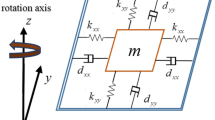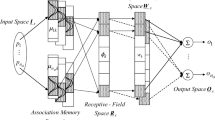Abstract
Current robot calibration schemes usually employ calibration models with constant error parameters. Consequently,they are inevitably subject to a certain degree of locality, i.e., the calibrated error parameters (CEPs) will produce the desiredaccuracy only in certain regions of the robot workspace. To deal with the locality phenomenon, CEPs that vary in differentregions of the robot workspace may be more appropriate. Hence, we propose a variable D-H (Denavit and Hartenberg)parameter model to formulate variations of CEPs. An FCMAC (Fuzzy Cerebellar Model Articulation Controller) learningalgorithm is used to implement the proposed variable D-H parameter model. Simulations and experiments that verify theeffectiveness of the proposed calibration scheme based on the variable D-H parameter model are described.
Similar content being viewed by others
Explore related subjects
Discover the latest articles and news from researchers in related subjects, suggested using machine learning.References
Ahmad, S.: Analysis of robot drive train errors, their static effects, and their compensation, IEEE J. Robotics and Automation 4(2) (1988), 117–128.
Albus, J. S.: A new approach to manipulator control: The Cerebellar Model Articulation Controller (CMAC), ASME J. Dynamic Systems Meas. Control 97(3) (1975), 220–227.
Albus, J. S.: Data storage in the Cerebellar Model Articulation Controller (CMAC), ASME J. Dynamic Systems Meas. Control 97(3) (1975), 228–233.
Azadivar, F.: The effect of joint position errors of industrial robots on their performance in manufacturing operations, IEEE J. Robotics Automat. 3(2) (1987), 109–114.
Bay, J. S.: Autonomous parameter identification by optimal learning control, IEEE Control Systems Magazine 13(3) (1993), 56–61.
Borm, J. H. and Menq, C. H.: Determination of optimal measurement configurations for robot calibration based on observability measure, Int. J. Robotics Research 10(1) (1991), 51–63.
Chen, J. and Chao, L. M.: Positioning error analysis for robot manipulators with all rotary joints, IEEE J. Robotics Automat. 3(6) (1987), 539–545.
Denavit, J. and Hartenberg, R. S.: A kinematic notation for low-pair mechanisms based on matrices, ASME J. Appl. Mechanics 77 (1955), 215–221.
Driels, M. R. and Pathre, U. S.: Significance of observation strategy on the design of robot calibration experiments, J. Robotic Systems 7(2) (1990), 197–223.
Driels, M. R. and Swayze, W. E.: Automated partial pose measurement system for manipulator calibration experiments, IEEE Trans. Robotics Automat. 10(4) (1994), 430–440.
Everett, L. J., Driels, M. R., and Mooring, B. M.: Kinematic modeling for robot calibration, in: IEEE Int. Conf. on Robotics and Automation, 1987, pp. 183–189.
Goswami, A., Quaid, A., and Peshkin, M.: Complete parameter identification of a robot from partial pose information, in: IEEE Int. Conf. on Robotics and Automation, 1993, pp. 168–173.
Gupta, K. C. and Kazerounian, K.: Improved numerical solutions of inverse kinematics of robots, in: IEEE Int. Conf. on Robotics and Automation, 1985, pp. 743–748.
Hayati, S. A.: Robot arm geometric link parameter estimation, in: 22nd IEEE Conf. on Decision and Control, 1983, pp. 1477–1483.
Hayati, S. A. and Roston, G. P.: Inverse kinematic solution for near-simple robots and its application to robot calibration, in: M. Jamshidi et al. (eds), Recent Trends in Robotics: Modeling, Control and Education, Elsevier, Amsterdam, 1986, pp. 41–50.
Hollerbach, J. M. and Bennett, D. J.: Autonomous calibration of single-loop closed kinematic chains formed by manipulators with passive endpoint constraints, IEEE Trans. Robotics Automat. 7(5) (1991), 597–606.
Jou, C. C.: A fuzzy cerebellar model articulation controller, in: IEEE Int. Conf. on Fuzzy Systems, 1982, pp. 1171–1178.
Judd, R. P. and Knasinski, A. B.: A technique to calibrate industrial robots with experimental verification, IEEE Trans. Robotics Automat. 6(1) (1990), 20–30.
Khalil, W., Gautier, M., and Enguehard, Ch.: Identifiable parameters and optimum configurations for robot calibration, Robotica 9 (1991), 63–70.
Kirchner, H. O., Gurumoorthy, B., and Prinz, F. B.: A perturbation approach to robot calibration, Int. J. Robotics Research 6(4) (1987), 47–59.
Latombe, J.-C.: Robot Motion Planning, Kluwer Academic, Dordrecht, 1991.
Lee, C. C.: Fuzzy logic in control systems: Fuzzy logic controller – Parts I and II, IEEE Trans. Systems Man Cybernet. 20(2) (1990), 404–435.
Miller, W. T., Glanz, F. H., and Kraft, L. G.: Application of a general learning algorithm to the control of robotic manipulators, Int. J. Robotics Research 6(2) (1987), 84–98.
Mooring, B.W. and Pack, T. J.: Determination and specification of robot repeatability, in: IEEE Int. Conf. on Robotics and Automation, 1986, pp. 1017–1023.
Nie, J. and Linkens, D. A.: A fuzzified CMAC self-learning controller, in: IEEE Int. Conf. on Fuzzy Systems, 1993, pp. 500–505.
Orin, D. E. and Tsai, Y. T.: A real-time computer architecture for inverse kinematics, in: IEEE Int. Conf. on Robotics and Automation, 1986, pp. 843–850.
Renders, J.-M., Rossignol, E., Becquet, M., and Hanus, R.: Kinematic calibration and geometrical parameter identification for robots, IEEE Trans. Robotics Automat. 7(6) (1991), 721–732.
Rene Mayer, J. R. and Parker, G. A.: A portable instrument for 3-D dynamic robot measurements using triangulation and laser tracking, IEEE Trans. Robotics Automat. 10(4) (1994), 504–516.
Roth, Z. S., Mooring, B.W., and Ravani, B.: An overview of robot calibration, IEEE J. Robotics Automat. 3(5) (1987), 377–385.
Shamma, J. S. and Whitney, D. E.: A method for inverse robot calibration, ASME J. Dynamic Systems Meas. Control 109 (1987), 36–43.
Stone, H. W. and Sanderson, A. C.: A prototype arm signature identification system, in: IEEE Int. Conf. on Robotics and Automation, 1987, pp. 175–182.
Vaishnav, R. N. and Magrab, E. B.: A general procedure to evaluate robot positioning errors, Int. J. Robotics Research 6(1) (1987), 124–129.
Veitschegger, W. K. and Wu, C. H.: Robot calibration and compensation, IEEE J. Robotics Automat. 4(6) (1988), 643–656.
Whitney, D. E., Lozinski, C. A., and Rourke, J.M.: Industrial robot forward calibration method and results, ASME J. Dynamic Systems Meas. Control 108 (1986), 1–8.
Wu, C. H.: A kinematic CAD tool for the design and control of a robot manipulator, Int. J. Robotics Research 3(1) (1984), 58–67.
Wu, C. H., Ho, J., and Young, K. Y.: Design of robot accuracy compensator after calibration, in: IEEE Int. Conf. on Robotics and Automation, 1988, pp. 780–785.
Zhuang, H., Roth, Z. S, and Hamano, F.: A complete and parametrically continuous kinematic model for robot manipulators, IEEE Trans. Robotics Automat. 8(4) (1992), 451–463.
Author information
Authors and Affiliations
Rights and permissions
About this article
Cite this article
Young, Ky., Chen, JJ. Implementation of a Variable D-H Parameter Model for Robot Calibration Using an FCMAC Learning Algorithm. Journal of Intelligent and Robotic Systems 24, 313–346 (1999). https://doi.org/10.1023/A:1008094014724
Issue Date:
DOI: https://doi.org/10.1023/A:1008094014724




